What should be the air speed in the ventilation duct according to technical standards
The microclimate provided by ventilation systems in a residential or industrial building affects the well-being and performance of people. To create comfortable living conditions, standards have been developed that determine the composition of air. Agree, regular air exchange is vital.
We will tell you what the air velocity in the duct should be. We advise you what to do so that the air flow always remains fresh and meets hygiene standards. Here you will find a detailed description of the calculation methods and a listing of the rules for selecting the optimal duct.
The information offered for familiarization is based on the data of normative directories. For the practical development of calculation methods, examples are given. The text material is supplemented by visual illustrations and videos, facilitating the perception of a difficult topic.
The content of the article:
The importance of air exchange for humans
According to construction and hygiene standards, each residential or industrial facility must be provided ventilation system.
Its main purpose is to maintain air balance and create a favorable microclimate for work and rest. This means that in the atmosphere that people breathe, there should not be an excess of heat, moisture, pollution of various kinds.
Violations in the organization of the ventilation system lead to the development of infectious diseases and diseases of the respiratory system, to a decrease in immunity, and to premature spoilage of food.
Pathogens quickly develop in an excessively humid and warm environment, and foci of mold and fungus appear on walls, ceilings, and even furniture.
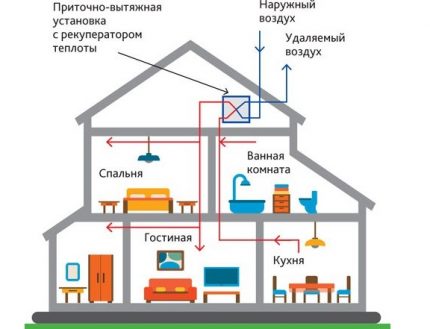
One of the conditions for maintaining a healthy air balance is the proper design of the ventilation system.Each part of the air exchange network should be selected based on the volume of the room and the characteristics of the air in it.
Suppose that in a small apartment there is a sufficiently well-adjusted supply and exhaust ventilation, while installation of equipment for forced air exchange is mandatory in production shops.
During the construction of houses, public institutions, workshops, enterprises are guided by the following principles:
- each room must be provided with a ventilation system;
- it is necessary to observe the hygienic parameters of the air;
- enterprises should install devices that increase and regulate the rate of air exchange; in residential premises - air conditioning or fans, provided there is insufficient ventilation;
- in premises for various purposes (for example, in wards for patients and the operating room or in the office and in the smoking room), it is necessary to equip different systems.
In order for ventilation to comply with the listed conditions, it is necessary to make calculations and select equipment - air supply devices and air ducts.
Also at ventilation system it is necessary to choose the right places for air intake in order to prevent the entry of polluted flows back into the premises.

The efficiency of air exchange depends on the size of the ducts (including house mines). We will find out what are the norms of the air flow rate in ventilation indicated in the sanitary documentation.
Rules for determining air velocity
The speed of air movement is closely interconnected with concepts such as noise level and vibration level in the ventilation system. Air passing through the channels creates a certain noise and pressure, which increase with an increase in the number of turns and bends.
The greater the resistance in the pipes, the lower the air speed and the higher the fan performance. Consider the norms of related factors.
No. 1 - sanitary noise standards
The standards specified in SNiP relate to residential premises (private and apartment buildings), public and industrial type.
In the table below, you can compare the norms for different types of rooms, as well as territories adjacent to buildings.
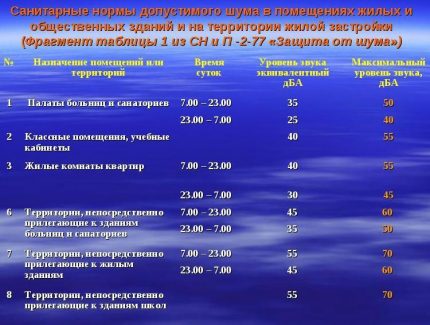
One of the reasons for the increase in accepted standards may just be incorrectly designed duct system.
Sound pressure levels are presented in another table:

No. 2 - vibration level
The power of fans is directly related to the level of vibration.
The maximum vibration threshold depends on several factors:
- duct dimensions;
- the quality of gaskets, providing a decrease in the level of vibration;
- pipe manufacturing material;
- the speed of air flow passing through the channels.
The norms that should be followed when choosing ventilation devices and when calculating air ducts are presented in the following table:
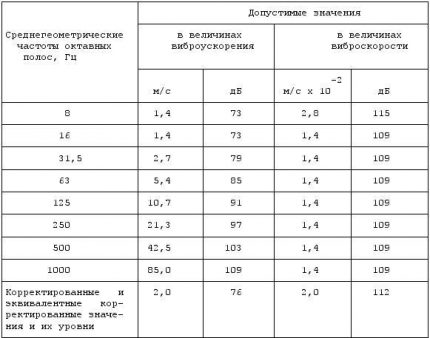
The air speed in the mines and channels should not affect the increase in vibration indicators, as well as the related parameters of sound vibrations.
No. 3 - air exchange rate
Air purification is due to the process of air exchange, which is divided into natural or forced.
In the first case, it is carried out when opening doors, transoms, window leaves, windows (and is called aeration) or simply by infiltration through cracks at the joints of walls, doors and windows, in the second - using air conditioners and ventilation equipment.
The change of air in a room, utility room or workshop should occur several times per hour, so that the degree of contamination of the air mass is acceptable. The number of shifts is the multiplicity, the value also necessary to determine the air speed in the ventilation ducts.
The multiplicity is calculated by the following formula:
N = V / W,
Where:
- N - the rate of air exchange, once every 1 hour;
- V - the amount of clean air filling the room for 1 h, m³ / h;
- W - the volume of the room, m³.
In order not to perform additional calculations, the average multiplicity indicators are collected in tables.
For example, for residential premises, the following air exchange rate table is suitable:
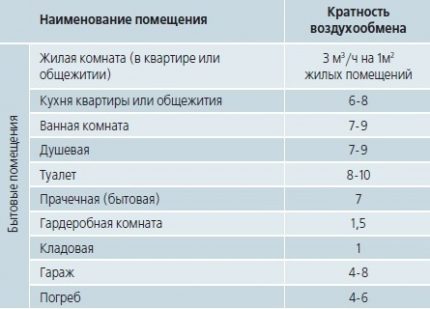
What will happen if the air exchange rate standards are not respected or are, but not enough?
One of two things will happen:
- The multiplicity is below the norm. Fresh air stops replacing polluted air, as a result of which the concentration of harmful substances in the room increases: bacteria, pathogens, dangerous gases. The amount of oxygen, which is important for the human respiratory system, decreases, and carbon dioxide, on the contrary, increases. Humidity rises to the maximum, which is fraught with the appearance of mold.
- Multiplicity is higher than normal. Occurs if the air velocity in the channels exceeds the norm. This negatively affects the temperature regime: the room just does not have time to heat up. Excessively dry air provokes diseases of the skin and respiratory apparatus.
To multiply the air exchange in accordance with sanitary standards, it is necessary to install, remove or adjust ventilation devices, and if necessary, replace the air ducts.
Air Velocity Algorithm
Given the above conditions and technical parameters of a particular room, you can determine the characteristics ventilation system, and also calculate the air velocity in the pipes.
It should be based on the multiplicity of air exchange, which is the determining value for these calculations.
To clarify the flow parameters, a table is useful:
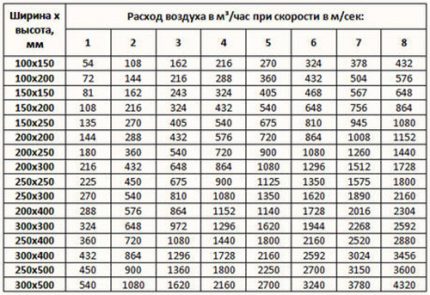
In order to make the calculations yourself, you need to know the volume of the room and the rate of air exchange for a room or hall of a given type.
For example, you need to find out the parameters for a studio with a kitchen with a total volume of 20 m³. Take the minimum multiplicity for the kitchen - 6. It turns out that within 1 hour the air channels should move around L = 20 m³ * 6 = 120 m³.
Also need to find out duct cross-sectional areainstalled in the ventilation system. It is calculated by the following formula:
S = πr2 = π / 4 * D2,
Where:
- S - cross-sectional area of the duct;
- π - the number "pi", a mathematical constant equal to 3.14;
- r - the radius of the cross section of the duct;
- D - the diameter of the cross section of the duct.
Suppose that the diameter of the round duct is 400 mm, substitute it in the formula and get:
S = (3.14 * 0.4²) / 4 = 0.1256 m²
Knowing the cross-sectional area and flow rate, we can calculate the speed. The formula for calculating the air flow rate:
V = L / 3600 * S,
Where:
- V - air flow rate, (m / s);
- L - air consumption, (m³ / h);
- S - cross-sectional area of air channels (ducts), (m²).
Substituting the known values, we obtain: V = 120 / (3600 * 0.1256) = 0.265 m / s
Therefore, in order to provide the necessary air exchange rate (120 m3/ h) when using a round duct with a diameter of 400 mm, it will be necessary to install equipment to increase the air flow rate to 0.265 m / s.
It should be remembered that the previously described factors - the parameters of the vibration level and the noise level - directly depend on the speed of air movement.
If the noise exceeds the norm, you will have to reduce the speed, therefore, increase the cross section of the ducts. In some cases, it is enough to install pipes from another material or replace a curved channel fragment with a straight line.
Recommended air exchange rates
During the design of the building, each individual site is calculated. In production, these are workshops, in residential buildings - apartments, in a private house - floor blocks or separate rooms.
Before installing the ventilation system, it is known what are the routes and sizes of the main highways, what geometry is needed ventilation ductswhich pipe size is optimal.
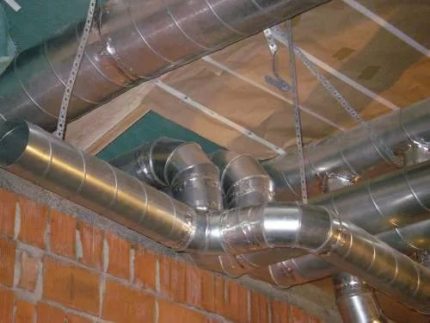
Calculations associated with the movement of air flows inside residential and industrial buildings are classified as the most complex, therefore, experienced qualified specialists are required to deal with them.
The recommended air speed in the ducts is indicated in SNiP - the regulatory state documentation, and when designing or commissioning objects they focus on it.
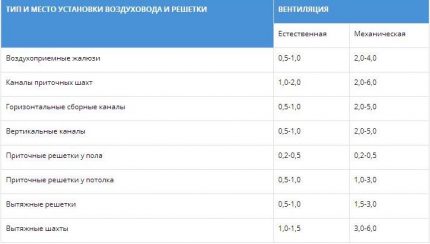
It is believed that indoor air speed should not exceed 0.3 m / s.
Exceptions are temporary technical circumstances (for example, repair work, installation of construction equipment, etc.), during which the parameters can exceed the standards by a maximum of 30%.
In large premises (garages, production halls, warehouses, hangars), often instead of one ventilation system, there are two.
The load is divided in half, therefore, and the air speed is selected so that it provides 50% of the total estimated volume of air movement (removal of contaminated or clean supply).
When force majeure circumstances arise, there is a need for a sharp change in air speed or a complete suspension of the ventilation system.
For example, according to fire safety requirements, the air speed is reduced to a minimum in order to prevent the spread of fire and smoke in neighboring rooms during a fire.
To this end, cut-offs and valves are mounted in the ducts and in the transition sections.
Subtleties of choosing a duct
Knowing the results of aerodynamic calculations, one can correctly select the parameters of the air ducts, or rather, the diameter of the round and the dimensions of the rectangular sections. In addition, you can select a device in parallel. forced air supply (fan) and determine the pressure loss during the movement of air through the channel.
Knowing the value of the air flow rate and the value of its speed, you can determine what section of the ducts are required.
To do this, take the formula inverse to the formula for calculating air flow:
S = L / 3600 * V.
Using the result, you can calculate the diameter:
D = 1000 * √ (4 * S / π),
Where:
- D - diameter of the cross section of the duct;
- S - cross-sectional area of air channels (ducts), (m²);
- π - the number "pi", a mathematical constant equal to 3.14 ;.
The resulting number is compared with factory standards allowed by GOST, and the products closest in diameter are selected.
If it is necessary to choose rectangular, rather than round ducts, then instead of diameter, determine the length / width of the products.
When choosing, they are guided by an approximate section, using the principle a * b ≈ S and size tables provided by manufacturers. We remind you that according to the norms the ratio of width (b) and length (a) must not exceed 1 to 3.
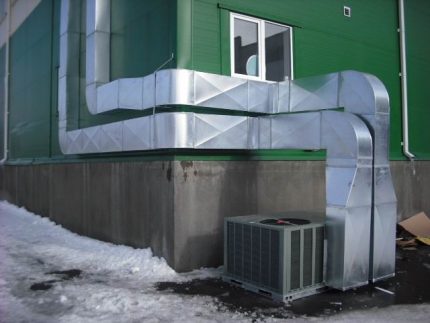
The generally accepted standards of rectangular channels: the minimum dimensions are 100 mm x 150 mm, the maximum dimensions are 2000 mm x 2000 mm. Round ducts are good because they have less resistance, respectively, have minimal noise levels.
In recent years, especially for indoor use, they have been produced convenient, safe and lightweight plastic boxes.
Conclusions and useful video on the topic
Useful videos will teach you how to work with physical quantities and help you better understand how the ventilation system works.
Video # 1. Calculation of natural ventilation parameters using a computer program:
Video # 2. Useful information about the ventilation system in a private house under construction:
The information in the article can be used for educational purposes and in order to better imagine the operation of the ventilation system.
For more accurate calculations of the air velocity when designing home communications, we recommend that you contact engineers who know the nuances of the ventilation device and help you choose the right duct sizes.
If you want to share personal experience gained with the installation of air ducts, interesting facts and specific information, please write comments in the block below. Ask questions about controversial issues. We or site visitors will be happy to participate in the discussion.

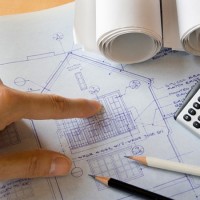 Calculation of air ducts for speed and flow rate + methods for measuring air flow in rooms
Calculation of air ducts for speed and flow rate + methods for measuring air flow in rooms  Requirements for air humidity in the catering unit: norms and rules for arranging ventilation in the catering unit
Requirements for air humidity in the catering unit: norms and rules for arranging ventilation in the catering unit 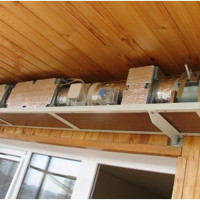 How to make a ventilation calculation: formulas and an example of calculating a supply and exhaust system
How to make a ventilation calculation: formulas and an example of calculating a supply and exhaust system 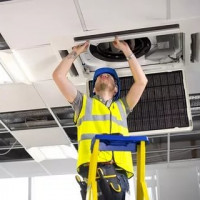 Design and installation of ventilation systems: the best schemes + installation nuances
Design and installation of ventilation systems: the best schemes + installation nuances  Checking ventilation at school: norms and procedures for checking the effectiveness of air exchange
Checking ventilation at school: norms and procedures for checking the effectiveness of air exchange 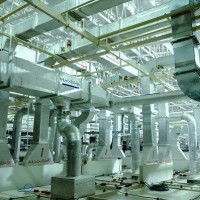 Requirements for ventilation of public buildings: subtleties of arrangement and design of ventilation
Requirements for ventilation of public buildings: subtleties of arrangement and design of ventilation  How much does it cost to connect gas to a private house: the price of organizing gas supply
How much does it cost to connect gas to a private house: the price of organizing gas supply  The best washing machines with dryer: model rating and customer tips
The best washing machines with dryer: model rating and customer tips  What is the color temperature of light and the nuances of choosing the temperature of the lamps to suit your needs
What is the color temperature of light and the nuances of choosing the temperature of the lamps to suit your needs  Replacement of a geyser in an apartment: replacement paperwork + basic norms and requirements
Replacement of a geyser in an apartment: replacement paperwork + basic norms and requirements
We began to pay attention to this after the birth of children. In the house, you always need to monitor ventilation and air. Therefore, I did not spare money for the installation of ventilation systems. I have one so far, and we have enough. Maybe in the future we’ll install another one. Without fresh air, it’s very difficult, especially since I work at home, and I don’t need to go out every day.
Unnecessary to go out, Pasha, you hit me. Be sure to read about the "circadian rhythms", which, of course, does not apply to ventilation, but is a driver of life processes.
I remember that Soviet doctors always advised children to take daily walks with a total duration of at least two hours a day. Briefly about the benefits of natural light, it synchronizes life processes in the body, affecting circadian cells located on the retina.